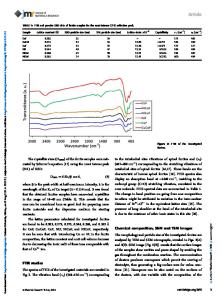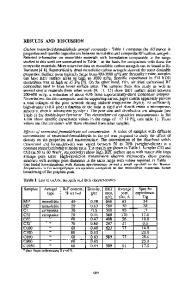Effects of heat-treatment on the spectroscopic and electrochemical properties of a mixed manganese/vanadium oxide film p
- PDF / 1,002,042 Bytes
- 7 Pages / 612 x 792 pts (letter) Page_size
- 25 Downloads / 323 Views
in films of mixed manganese (mainly 4+) and vanadium (5+) oxides deposited electrochemically on a platinum substrate have been heat-treated under vacuum at various temperatures between 25 and 400 °C. Electron spin resonance and x-ray photoelectron spectroscopy revealed that the reductive formation of Mn2+ occurs at 300 °C only in the presence of vanadium within the film. This phenomenon can be regarded as a result of electron transfer from V4+ ions generated thermally to neighboring Mn sites. Voltammetric response of the heat-treated Mn/V oxide film in borate solution was enhanced with increasing the number of potential cycles, and the steady-state current was much larger than that of pure manganese oxide. Vanadate ions were diffused from the film to maintain the charge balance during the repetition cycles. The resultant porous structure can allow easier mass transport of protons to electrically conductive Mn oxide surface, offering the improved charge–discharge performance of the electrode.
I. INTRODUCTION
Manganese oxides are of particular interest because they readily intercalate cations into their structure and are therefore potentially useful for charge storage applications such as cathodes in lithium batteries1,2 and recently supercapacitors.3,4 Electrochemistry of transition metal oxides is closely related to electronic conductivity in solid phase and ionic mobility in the pores. Thus, their electrochemical responses are strongly affected by preparation and posttreatment procedures. For example, incorporation of other transition metals into the host oxide is a common approach for improving electrochemical performance.5−7 Kim et al. have synthesized amorphous Mn/Pb and Mn/Ni mixed oxides at ambient temperature by chemical reduction of KMnO4 with Pb2+ and Ni2+ salts.7 They found that the specific capacitances of the mixed oxides were much larger than that of pure manganese oxide due to an increase in the surface area resulting from the formation of micropores. Furthermore, the capacitance of the Mn/Pb oxide was increased by an appropriate heating process. Hence, the method for preparing such mixed transition metal oxides with a thin film form is required for potential microelectronic
II. EXPERIMENTAL
a)
Address all correspondence to this author. e-mail: nkymm@yamaguchi−u.ac.jp DOI: 10.1557/JMR.2004.0202 J. Mater. Res., Vol. 19, No. 5, May 2004
http://journals.cambridge.org
applications, and it is a matter of great importance to investigate the effect of heat-treatment on their structural and electrochemical properties. Thin oxide films adhering well to a conducting substrate need no binders or conducting agents in their electrochemical use. Among the many procedures developed for the fabrication of thin films, the electrodeposition method is suitable for obtaining uniform films on substrates of complex shapes with high reproducibility. It also gives low environmental loading and produces materials at low cost. Previously, we have reported a new electrochemical route for preparing amorphous films of mixed
Data Loading...










